Unlike many of the hyped-up bodybuilding and fitness supplements out there, whey protein is an absolute must if you’re looking to build muscle and/or burn fat while preserving hard-earned muscle (1).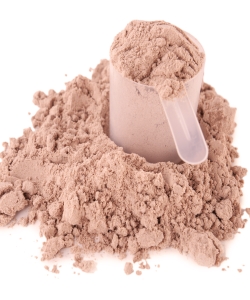
Whey is the most easily-digested type of protein found in dairy products, making up 20% of its total protein content. Unlike the 80% of casein found in dairy; whey is virtually lactose-free, particularly when taken in hydrolyzed form. (2)
Despite the benefits of this miracle superfood, you really have to educate yourself to avoid over-spending on useless fillers and other ingredients, while also learning how to spot manufacturer deception in the form of tricky labeling practises which include false claims and over-inflated serving sizes.
Continue reading to learn more about the many benefits whey protein offers, how to spot the best products, and our list of the current best whey protein powders available.
What Makes Whey Protein Different?
Whey is the most bioavailable form of protein found on the planet. When taken on an empty stomach, mixed with water only, its fully digested and absorbed by the intestines within 1.5 hours – start to finish. This is a key benefit when looking for an easy, complete, amino-rich protein source to begin recovery from a strenuous workout.
Learn more about whey’s absorbtion rate and ideal dosing recommendations: here and here
Top 9 Whey Protein Powders
#1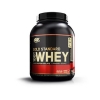 |
Optimum Nutrition Gold Standard 100% Whey Protein Powder | More Info |
#2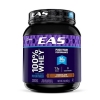 |
EAS 100% Whey Protein | More Info |
#3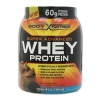 |
Body Fortress Super Advanced Whey Protein | More Info |
#4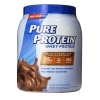 |
Pure Protein 100 % Whey Protein | More Info |
#5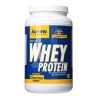 |
Jarrow Formulas Whey Protein | More Info |
#6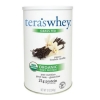 |
Tera’s Organic Whey Protein Powder | More Info |
#7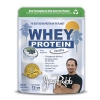 |
Jay Robb Enterprises Whey Protein | More Info |
#8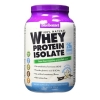 |
Bluebonnet Nutrition 100% Natural Whey Protein Isolate Powder | More Info |
#9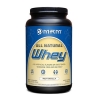 |
MRM 100% All Natural Whey Protein Powder | More Info |
Benefits of Using Whey Protein
1.Faster Recovery
Drinking 25 grams of whey right after a workout gives the body all the amino’s it needs to immediately begin repairing damaged muscle tissue, resulting in less exercise-induced inflammation, and speeding recovery by up to 24 hours. Many whey formulations also include supplemental glutamine, which further speeds up the recovery process. (6), (7), (8)
2.More Strength Gains
Speedier recovery means you’ll get stronger, faster. Taking 25g of whey directly before your workout can also boost strength levels by up to 10% or more, especially if you’re the type of person who skips meals or doesn’t follow a healthy diet.
3.Less Catabolism
Catabolism, the process by which the body breaks down muscle tissue for energy, is a natural process used to replenish energy stores when a person isn’t taking in enough calories. Worse, even despite an adequate diet, the “catabolic effect” takes place every time we fast, particularly during sleep. Whey starts to digest in as little as 20 minutes, flushing blood with valuable protein to curb catabolism in its tracks.
4.Easy, Complete Protein Source
Whey mixes more easily than all other powdered protein sources, making it easy to toss in a shaker or blender with some water and get immediate protein into your body, no matter where you are or what you’re doing. Non-flavored whey mixes easily with any food, and has no taste compared to casein and egg protein powders.
5.Loads of Essential Amino’s
Whey protein contains all 18 amino acids found in nature, in larger quantities than those typically found in most whole foods; red meat being the only exception. In particular, whey has large amounts of all 9 essential amino’s: leucine, isoleucine, valine, threonine, phenylalinine, methionine, lysine, histidine, and tryptophan. Most whey formulations contain at least 5g of BCAA’s (leucine, isoleucine, valine) which account for 35% of the amino’s in muscle tissue. (12), (13), (14)
6.Anti-Aging
Due to its high ratio of essential versus non-essential amino acids, and in particular the large amounts of available BCAA’s, whey has shown to reduce and even reverse the signs of aging in elderly patients (source).
7.Fat-Burning
This benefit is profound when it comes to those on a calorie-restricted diet looking to lose weight. The bioavailability of the protein found in whey helps to preserve muscle mass in the face of mild or even extreme caloric restriction, keeping the metabolism fired up and burning fat instead of muscle. (9),(10), (11), (15)
Types of Whey Protein Available
The form of the whey you’re buying can be just as important as the brand you choose:
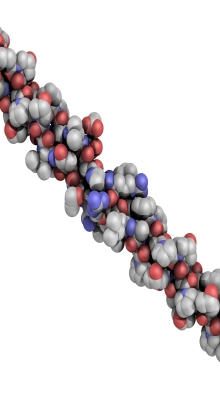
1. Whey Concentrate
Has more fat, cholesterol, and carbs in it than other forms. Concentrate is easily digested, but considered lesser quality than the next two.
2. Whey Isolate
Costs a little more than concentrate and has almost no fat or cholesterol, and near-zero carbs. Few studies have shown that isolate is in any way superior to concentrate.
3. Hydrolyzed Whey
The most expensive, yet easily-digested whey on the market. It’s “pre-digested” making it the subject of intense discussion due to its supposed “enhanced bioavailability.” You’ll pay more for hydrolyzed. It contains near-zero lactose, as proven in lab studies and from the personal accounts of intolerant individuals. (5)
For the most part, which type you choose will come down mostly to personal preferences and how much money you want to spend.
Both whey concentrate and isolate have enough lactose in them to cause a reaction in intolerant individuals. Isolate, like hydrolyzed, has near-zero fat and cholesterol if that’s important to you.
Hydrolyzed is the best option if you are lactose intolerant and looking for a reaction-free, high quality protein supplement. It may be that it absorbs better than the other two types of whey, but most dependable sources say the fact that it’s predigested doesn’t actually lead to improved absorbtion (learn more).
Note About Whey Protein and Diabetes
You may have heard whey touted as a cure for type II diabetes. There’s absolutely no truth to this claim, despite its popularity all over the Internet. Though it may lead to increased insulin sensitivity in non-diabetics, making it a possible preventative when combined with a low-sugar diet (source).
In fact, if you’re a type-I or type-II trying to limit your blood sugars, it’s important that you understand any protein that isn’t used immediately will be converted to sugar by the liver. Since whey digests, start to finish, in approximately 1.5 hours, diabetics should be aware that whey is very likely to spike post-meal blood sugars, particularly if you lead a sedentary lifestyle. If you’re diabetic, only take the recommended dose (shown next) and preferably only before your workout.
Ideal Dosage
The ideal dosage of whey protein for most people is 20 – 30 grams at a time, if you’re looking for maximum absorption and use by the body. Consuming up to 50 grams of whey in one sitting may offer more in the way of suppressing appetite while dieting or if you’re an extreme athlete with increased ability to digest protein. However, several studies have shown that 25 grams seems to offer the best bioavailability advantages.
How Much Whey Protein Do We Need?
Hardcore bodybuilders consume up to 4 grams of protein per pound of bodyweight every day. Reading such claims in bodybuilding magazines can really blur the lines when it comes to finding out just how much daily protein is right for a non-competitive athlete (who doesn’t take steroids which are known to quadruple protein synthesis in the body.)
It’s important to remember that these athletes aren’t leaving anything to chance with such amounts in an effort to eek out every ounce of new muscle they can in between competitions, and are very likely straining their kidneys to dangerous extremes.
Recommendations for Total Whey Protein Intake:
People who don’t do moderate or high intensity exercise, but are still active (ie., walking, water aerobics, casual bicycling, gardening, housework, etc):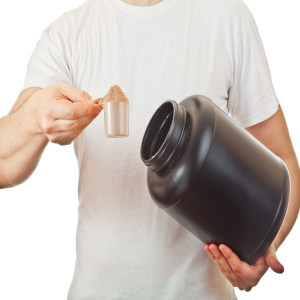
• 0.4 – 0.5 grams of total protein per pound of bodyweight every day.
Mildly active people who exercise 3 – 5 days per week at a moderate or high intensity level for 30 – 40 minutes at a time:
• 0.6 grams of total protein per pound of bodyweight every day.
Amateur bodybuilders, professional athletes and people who work in physically demanding jobs 5 or more days per week:
• 0.9 – 1.2 grams of total protein per pound of bodyweight every day.
Use this protein calculator to determine how much protein you need every day.
Warning
Our kidneys have to filter excess protein from the blood. One of their unique jobs is to recycle unused protein and prevent it from being excreted in our urine. This is a survival feature that all animals and humans have, to ensure we have amino’s (aka. “the building blocks of life”) when food becomes sparse or when tissues break down during exercise and aren’t immediately replenished by eating or drinking more protein.
How Much Whey Protein to Include in the Diet?
You need to consume real food in order to maximize muscle and health gains and avoid any side effects.
• In general, professional and amateur athletes can consume 25 – 50 grams of extra protein from whey shakes daily (preferably in the morning and before and/or after a workout), in addition to dietary sources to get to their protein goals every day.
• Non-athletes and people who engage in casual physical activity, who’re looking for fat-loss benefits, should stick to 25 – 30 grams once a day in the morning, to curb food cravings and help fire up the metabolism.
Consuming more than what’s recommended will result in you literally “pissing your money away”. In addition to the disruptive side effects mentioned in the next section.
Warning About “More is Better”
More is not better…
We do need protein to recover. But don’t fall into the trap of thinking that more protein will equal faster results. The body can only synthesize so much at a given meal and over the course of a day. The kidneys will have to work double-time if you decide to double or triple your intake in an effort to get more results from a workout, or when trying to speed up recovery after surgery or certain health problems.
Excess protein, which we take to speed up recovery, will actually lead to excess inflammation throughout the body, making consuming more a counter-intuitive “faux pas” that can hurt more than help. The dangers of getting too much have been studied to death and include: weight gain, candida infections in the body, increases in insulin resistance (ie., diabetes and pre-diabetes), increased risk of many types of cancers, and in general – dying faster!(3),(4)
Just enough, perhaps a tiny bit extra, is all you need.
Learn more about the dangers of consuming too much protein here: The Very Real Risks of Consuming Too Much Protein
What to Look for Before You Buy a Whey Protein
1.Manufacturer’s Reputation
The bodybuilding and fitness communities found online and off, can be very fickle when it comes to their protein and supplement sources. Everyone has an opinion and even the most popular manufacturer will have their detractors. Still, it’s important to research the company who makes the whey you’re consuming, to determine the kind of standards they have.
2.Calories
Don’t spend your hard-earned money on excessive fat and sugar calories in your whey. For all intents and purposes, a typical serving of 100% whey, containing ~24g of protein, shouldn’t exceed 150 calories, with most brands falling somewhere in the 100 – 130 cal range.
3.Serving Size
A larger serving size means you’re paying for, and consuming fillers such as fat, carbs, and sweeteners. Worse, protein concentrations – per scoop or per serving – can vary significantly. Read the fine print on the label. For instance: “Manufacturer A” might dupe you into thinking you’re getting a great deal with their 5 lb bag of whey, containing 80 complete servings. “Manufacturer B” might only offer 40 servings for their 5 lb bag. However, when you read the fine print, “Manufacturer A” requires 2 servings of their whey to get the equivalent amount of protein as “Manufacturer B” does in one.
4.Ingredient List
A massive list of ingredients means, as with excess fat, carbs and sweeteners, that you’re paying for junk you don’t need. Basic math skills come in very handy when it comes to determining the fillers and lab-made chemicals you’re consuming with your whey. Subtract the protein content, and other beneficial additives like creatine and glutamine in a single serving size, from the weight listed on the serving size. What you’re left with is extra “filler weight” you’re consuming, which is not the pure whey protein or performance additives you think you’re paying for.
5.BCAA’s
Most manufacturers ensure that each serving size of their product contains at least 4 – 5g of BCAA’s (leucine, isoleucine, valine). Even the cheapest brands do this, so there isn’t much sense buying a product that doesn’t, when you consider the benefits they offer.
6.Easy Mixing
Nearly all products will be labeled as “Easy to Mix” or something similar. Read Amazon reviews and listen to the chatter on bodybuilding and fitness forums to find out just how much effort’s required to get a clump-free, chalk-free shake. Generally, the higher the quality of whey used, and fewer additives a product contains, the easier it should be to mix without a high-speed blender.
Whey Protein Powder Reviews
1.Optimum Nutrition 100% Whey Gold Standard
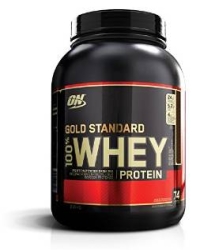
Where to buy: Amazon
This 5lb container of ON is arguably the best whey isolate you’ll find anywhere. It’s a favorite among bodybuilders who claim that they gain more muscle while consuming ON than any other whey protein. ON is the “Gold Standard” and also one of the biggest sponsors you’ll find at nearly every bodybuilding competition imaginable.
Each serving contains 24g of protein, 5.5g of “instantized” BCAA’s, and just 1g each of fat and sugar. Best, they offer 20 unique flavors to choose from!
2.EAS 100% Whey Protein
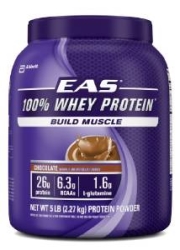
Where to buy: Amazon
EAS is a caliber of commercial protein in the same class as ON. This product may have a head up on the ON listed above though, since it does have glutamine in each scoop. The name sells this product at this point, as their reputation is beyond reproach.
The label lists each serving as coming with: 150 calories, 26g of protein, 2g of fat, 6g carbs, and 6.5g of BCAA’s. The price is slightly lower for this product than the ON above, particularly if you’re comparing 5lb or larger container sizes.
3.Body Fortress Super Advanced Whey Protein
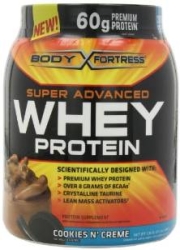
Where to buy: Amazon
Body Fortress makes some of the most affordable whey protein and performance supplements on the market. This power-packed whey formulation holds some real promise for people who want to maximize muscle gains on a budget; though you do want to read the label carefully, as you’ll see “60g Premium Protein” and “Over 8g BCAA’s” in bold on the packaging, when in fact the small print tells us that those numbers are achieved when you mix 2 servings together at once.
The advertising trickery is forgivable though, since you’re still getting a whopping 30g protein, and over 4g of BCAA’s per 1-scoop serving size. There are a couple of drawbacks to this Body Fortress Advanced Whey, that may or may not affect your buying decision. First and foremost is the “Super Recovery Blend” of creatine, glutamine, and alanine. The creatine values aren’t listed, so it’s unsure if there would be any in-exercise performance benefits. Second, the sugar content per scoop is high, at 7g. These are minor when considering the low price, but are worth noting nonetheless.
4.Pure Protein 100 % Whey Protein
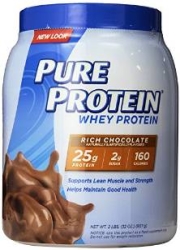
Where to buy: Amazon
One nice thing about Pure Protein Whey, other than its 25g of combined whey concentrate and isolate, is the variety of flavors they offer. They offer regular low-calorie vanilla and chocolate, containing only 2g of carbs. But also offer 3 “Natural” flavors for people with more of a sweet tooth, containing 6g of carbs per serving. The label claims 5g of BCAA’s are included.
Pure Protein is a great product, despite the fact that several reviews have pointed out that the company changes their formulation a little too often, adding more sugar to satisfy buyers who want a better-tasting product.
5.Jarrow Formulas Whey Protein
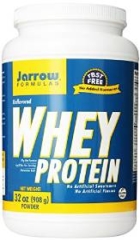
Where to buy: Amazon
This product is really interesting for those of you who don’t want to be consuming genetically-modified products. This whey protein is GMO and rBST free and also contains no gluten, nuts, shellfish, or egg ingredients – all of which are known to cause mild to life-threatening reactions in some people.
When you read the ingredient list, the purity of this product becomes very obvious, with just 93 calories per 23g serving, 18g of whey, 2g of carbs, 1g fat, with 4g of BCAA’s in the protein itself. One drawback for some, and a benefit for others will be that this is an unflavored product, making it perfect for mixing with your favorite beverages and foods.
6.Tera’s Organic Whey Protein
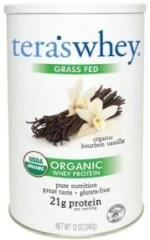
Where to buy: Amazon
Tera’s Organic Whey is sourced from grass-fed cows and labeled as a weight loss product, as opposed to a muscle-builder. It contains 20g of protein per serving, and is flavored with all-natural vanilla bean and stevia. Stevia is a natural, non laboratory-made sweetener; one of a few low-carb sweeteners that have no known long-term side effects.
Expect to pay more money per serving due to the grass-fed label and more expensive stevia sweetener used. However, if you’re looking for an organic product, you can’t go wrong with Tera’s!
7.Jay Robb Enterprises Whey Protein
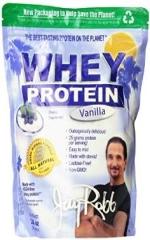
Where to buy: Amazon
Jay Robb is a favorite among organic purists. The whey is also sourced from grass-fed cows, and the protein content is a little higher than Tera’s, at 25g per serving. Each serving contains 100 calories. Upon reading the reviews, you’ll note that users prefer this product to many other organic formulations, due to the natural taste and low levels of sweetener (stevia) that are included in each serving.
This is a low-carb product, with little-to-no fillers used. As with all organic products, the price tag is definitely higher, but that’s a price that people who don’t want to consume needless and harmful animal hormones, sugar, and artificial sweeteners, are willing to pay!
8.Bluebonnet Nutrition 100% Natural Whey Protein Isolate Powder
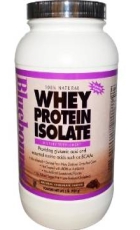
Where to buy: Amazon
Bluebonnet is another grass-fed, 100% organic product, with a price that’s a little easier to “digest” than the more popular Tera’s or Jay Robb. It’s certified to be GMO, soy, and gluten-free and high in whey protein content.
The label lists the following: 116 calories, 26g protein. While not much else is listed about this product, the reviews are overwhelmingly positive, and the protein content is one of the highest per serving you can find when comparing Bluebonnet to other organics.
9.MRM 100% All Natural Whey Protein
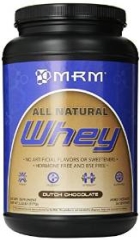
Where to buy: Amazon
MRM is another all-natural product, that actually costs much less than Tera’s or Jay Robb. While MRM claims to be hormone-free and containing no artificial sweeteners, they don’t have grass-fed listed on the label, so the “100% Natural” on the label as opposed to “100% Organic” can raise some suspicious eyebrows.
Just the same, the label’s promising for low-carbers who just want the protein. Each 25g serving size comes with only 85 calories, 18g of protein, and less than 1g of both fat and carbs. Best, MRM offers over 10 different and exciting flavors ranging from chocolate and vanilla, to mixed berries and watermelon!
Conclusion
We hope that you now feel confident about how to find the best whey protein powder for your specific needs. Any of the commercial or organic options listed above will give you great results, and excellent savings when you purchase them on Amazon using a Prime membership.
Just remember to always compare and read labels, and never settle on a product just because it’s the current trend you read about in muscle, fitness, and dietary publications.

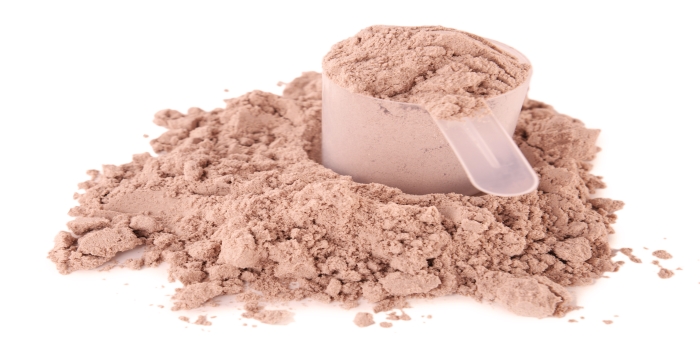



I bought some whey protein powder awhile back when I first got into going to the gym. An article like this would have been helpful! I ended up going with an all-natural, low-sugar power with a chocolate flavor. It never feels chalky or like a protein powder shake is expected to taste if you shake it well.
I use amino acid supplement instead of whey protein. My instructor told me it is more effective.